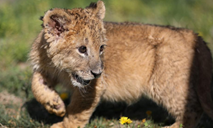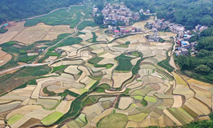Native Americans still face challenges in COVID-19 pandemic
LOS ANGELES, May 15 (Xinhua) -- It's a familiar landscape of Native Americans' communities in the West: red sandstone, yellow-tinged sagebrush, a blue sky canopy that meets rolling mountain peaks, with cattle and horses dotting the meadows.
A newer addition to the timeless landscape in the last two years is a series of hand-lettered turquoise signs along the roads in those rural regions, such as "Stay home, protect our elders" and "Native people are resilient, resourceful, kind, and most of all hopeful."
DISPROPORTIONATE LOSSES
The daily curfew for residents on the Navajo Nation, which has the largest land area retained by a Native American tribe in the United States, was lifted on Aug. 6 after it had been enforced for about 17 months, but the indoor mask mandate is still in effect despite policy changes in the states of Arizona, New Mexico and Utah.
The Navajo Nation covers parts of those three states, which all have lifted their mask mandate this spring. Tribal leaders reaffirmed maintaining the strict coronavirus protocols such as mask wearing in public since COVID-19 has taken a disproportionate toll on Native Americans.
On Feb. 24, one day before the so-called "People's Convoy," a group of truckers that oppose COVID-19 guidance, arrived at the Arizona portion of Navajo Nation, the Nation's President Jonathan Nez emphasized the need for tribal citizens to protect themselves and their loved ones.
"Please get fully vaccinated, which includes a booster shot," Nez warned, "Our mask mandate remains in effect in all public places within the Navajo Nation. Please take precautions and be extra cautious in public."
Nine new COVID-19 cases and one death were reported on March 11 and the total number of deaths in Navajo Nation reached 1,656, according to the latest data released by the Navajo Department of Health, in coordination with the Navajo Epidemiology Center and the Navajo Area Indian Health Service.
On the same day, the state of New Mexico reported 264 new cases and Utah 244 new cases. Arizona now only reports COVID-19 cases on a weekly basis each Wednesday.
"COVID-19 remains a priority for the Navajo Nation as we continue relying on the guidance of our public health experts as we move forward. Case numbers are low at the moment, but we have to be cautious and prepared in the event that another variant begins to spread," Nez said in a statement.
This message reflects how far the Navajo Nation has come in battling and recovering from COVID-19, and how it remains vigilant against the fatal disease.
In June of 2020, the Navajo Nation, with a population of 173,667 on the 2010 census, surpassed New York and New Jersey, both regarded as hot spots of the pandemic, with the highest per-capita coronavirus infection rate in the country, showing a clear sign of COVID-19's disproportionate impact on minority communities.
"ENDANGERED SPECIES"
Besides Navajo Nation, almost all Native Americans' communities, from Choctaw Nation in Oklahoma to Pinoleville Pomo Nation in California, experienced at least two waves of death surges since the pandemic started.
A blog of California Health Care Foundation detailed some painful stories about Native American families in the crisis.
Heather Yazzie was sent to hospital in 2020 summer with her father, a member of the Navajo Nation, and her mother, part of the Pala Band of Mission Indians. All three were being treated for COVID-19.
Heather was released the next day, but her parents had to stay. "Dad, I love you," she told her father before she left. "You're gonna be okay." Shortly after they spoke, he died. Since then, Heather lost five other relatives to the pandemic.
Leticia Aguilar, a Native American living in Sacramento, lost her grandmother and aunt within four days in 2020 to COVID-19. She said she was greatly relieved that they would at least be counted. "It meant a lot for us as natives."
The blog noted that like so many communities of color, Native Americans had been devastated by the virus, but the data may not reflect the full extent of the toll COVID-19 has taken on them.
The communities of Native Americans always worry that their loss is not being fully recognized by a state data system that is misclassifying Native Americans as Latinx or multiracial, and that the deaths could lead to an irreplaceable cultural devastation.
"When people talk about minorities being affected, well, tribal people in this country are not in the minority. We're an endangered species," said Moke Simon, chair of both the Lake County Board of Supervisors and the Middletown Rancheria of Pomo Indians of California, a few weeks into the initial stay-at-home order.
"There's only two and a half million left of us," he said. "And it's very scary."
Shaydreanna Jackson, a Hualapai living with the Havasupai people near the Grand Canyon region, told local indianz.com that the pandemic is scary for her tribe as well.
"We're already small as it is, and we've had a lot of cases out there and it's taken quite a bit of our elders," Jackson said. The Hualapai Tribe, with a population of 1,621, had 206 positive cases overall last December, according to data from the tribe's COVID-19 tracker.
COVID-RELATED DISCRIMINATION
U.S. President Joe Biden announced early March that he nominated veteran health administrator Roselyn Tso, an enrolled member of the Navajo Nation, to lead the Indian Health Services (IHS), the federal agency delivering health care to more than 2.5 million Native Americans and Alaska Natives.
The agency runs two dozen hospitals and about 90 other health care facilities around the country, most of which are small and on or near Native American reservations. Other hospitals and health care facilities are run by tribes or tribal organizations under contract with the agency.
The IHS has been the focus of congressional hearings and scathing government reports. The position of director has been absent for a long time.
The National Indian Health Board recently outlined expectations for a new director, including advocating full and mandatory funding of the IHS, consulting with tribes in a meaningful way, investing long-term in public health infrastructure and keeping tribes up to date on agency actions and funding decisions.
But COVID-related discrimination could be a tougher challenge for the IHS. People from all major racial and ethnic minority population groups in the country have reported experiencing this problem, according to a research conducted by National Institute on Minority Health and Health Disparities, part of the National Institutes of Health.
The research, published in the American Journal of Public Health on Feb. 23, collected information from 5,500 American Indian/Alaska Native, Asian, Black/African American, Hawaiian and Pacific Islander, Latino, White, and multiracial adults.
The survey asked whether participants had experienced COVID-related discriminatory behaviors, such as being called names or insulted, being threatened or harassed, or hearing racist comments, because the perpetrator thought the participant had COVID-19.
The survey also asked whether participants felt that others acted afraid of them because they belonged to a racial or ethnic group misconceived to get COVID-19 more often.
Results showed that 22.1 percent of participants had experienced COVID-related discriminatory behaviors, and 42.7 percent reported that people acted afraid of them. Participants identified as Asian or American Indian/Alaska Native were most likely to have experienced those hostile behaviors.
"COVID-19-related discrimination is common, and it appears that the pandemic has exacerbated preexisting resentment against racial/ethnic minorities and marginalized communities. Efforts are needed to minimize and discredit racially driven language and discrimination around COVID-19 and future epidemics," the researchers concluded.
Photos
Related Stories
Copyright © 2022 People's Daily Online. All Rights Reserved.










